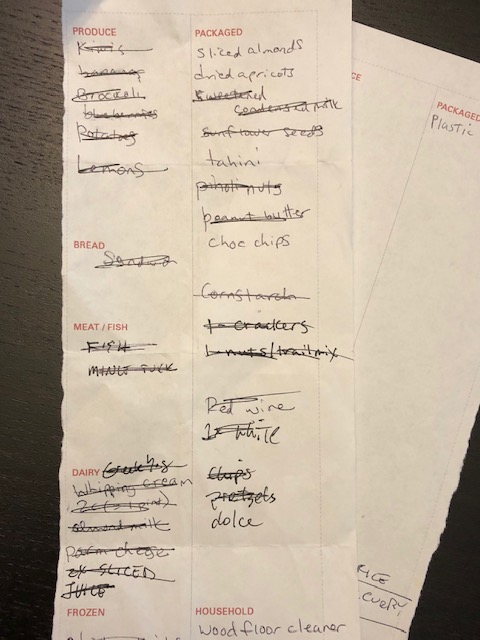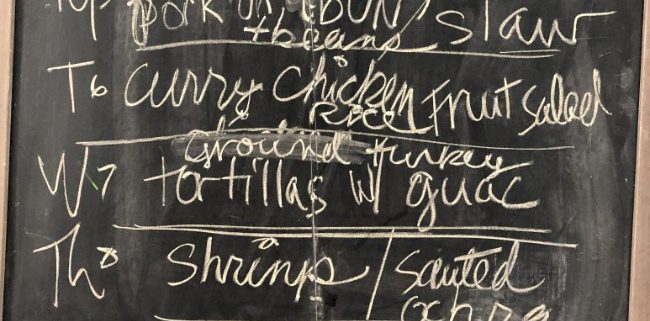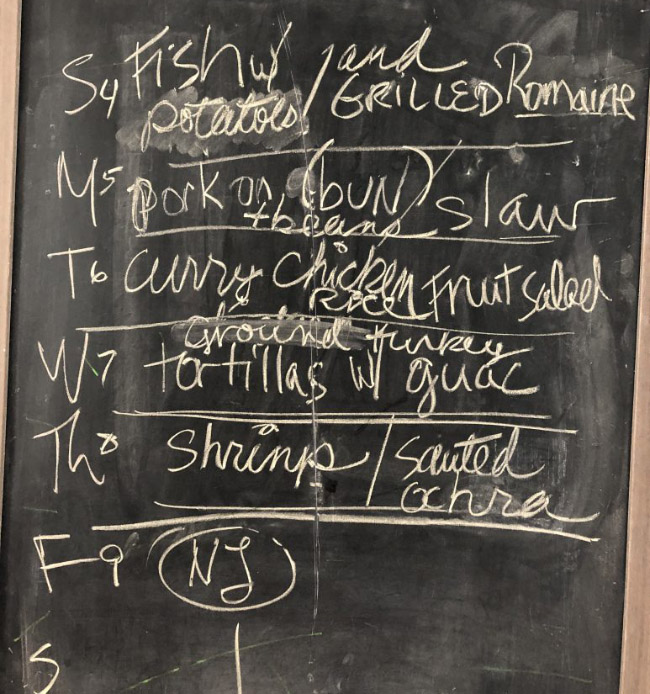Meal Planning 101
Cary, NC – We get it. Everyone leads very busy lives these days. But that doesn’t mean you have to eat your meals based on the drive-thru menu at Chick-Fil-A. With a little planning, you will spend less, waste less, and eat healthier. Here’s our primer on Meal Planning 101.
Back during the Great Recession, we had to save money, any way we could, and the grocery bill was the first place we looked (after cutting cable and eliminating any expenses that we deemed frivolous). But one thing we noticed with our weekly trips to Harris Teeter, was that our family of four was starting to spend close to $300 a week on groceries and a lot of that was junk. Admittedly we have always been big on eating at home and we enjoy cooking. If you don’t this story might not be for you.
What we discovered when we shopped at the big box grocers was that we spent a lot of our food budget on all that name brand stuff, and it was mostly junk food. And it adds up.
Here’s how we lowered our bills to about $150/week.
The Weekly Menu
To make your menu, give yourself about an hour of planning time. There are a few things to consider before you start making a menu and it pays dividends if you spend the time to plan. Really. We usually do this Saturday morning right before we head out the door. We leave inspired!
We have a big blackboard in our kitchen that we use for our menu. Before that, we used a whiteboard stuck to the front of the fridge. Whatever floats your boat, but make it with the days of the week listed and space to list out what you plan to make for each night. We don’t get into lunches and breakfasts, but we do have them considered in the grocery list.
Next, take a look at what the week ahead holds for you. Are there after work meetings? Sports practice pickups or games? Is anyone traveling? List these directly on the menu board so you can adequately consider them. Know who you are cooking for and if there are any nights the chef(s) will be short on time. This all plays into what you will be planning to cook each night. No sense making a labor-intensive meal when only two of the family members will be home. Ditto for a night when you need something quick.
What’s on Hand?
Try to use what you have. When we make our menu, we first take a look in the vegetable bin and the fruit drawer, to see if anything in there is very ripe, we plan for use early in the week. Then look in the freezer. What meats or frozen ingredients do you have on hand? What’s in your pantry and what’s depleted?
Planning a meal should be easy. While I love to peruse cookbooks and cooking magazines (and isn’t Pinterest great for tagging recipes?) start simple. We usually pick a night for pasta, a night for fish, a night for tortillas (because they use up leftovers so well), and then chicken or pork. If you know you want to eat out one night, or several, plan those into the schedule. That will eliminate the over-buying of ingredients don’t get used in any meal. If a meal will create leftovers, plan when those will be used. Or cook/ prep some of the ingredients for use later in another meal (that’s probably Meal Planning 201!).
Think about what will go with these main ideas. If you have a salad planned, what ingredients do you need, vs. what is already on hand? Having a pasta dish? Do you need a red sauce, or are you making it from scratch? Do you like curry chicken as a main dish? Are you making the sauce from scratch, or purchasing a jar of sauce? And are you serving that with Naan bread or over rice?
If you like to look up recipes, still start with this basic plan, and then look through your inspiration and fill in which nights you use the recipes for, and which nights you cook from memory.

Make A List
Make a list and stick with it. After you have established your menu, now double-check if the recipes require items you need to shop for. It really saves you time and money to know what you have available. And it goes without saying that you should have certain staples on hand: rice, pasta, a can of chopped tomatoes, assorted canned or dried beans, flour, sugar, baking powder and baking soda, cornstarch as well as a basic set of spices. These should also be added to the list as soon as you run out of the item, so you know when you need it.
Look at the grocery list and organize it by where the items are in the store. We made our own template years ago, and keep it saved on the computer to print out when we need it. Some people like phone apps. There are even apps that can be shared within a family. categories we like include Bread, Produce, Dairy, Meat, Frozen, Fish, Packaged, Household, and Misc.
Look at each menu item and consult the recipes to be sure of what is on hand and what needs to be purchased. Add items methodically. Then fill in with those breakfast and lunch items you know you need such as the kids’ cereal choices, and lunchbox staples. Then lastly double-check your household items like cleaning products and toilet paper. (This was about meal-planning right? Got it!)
Now to Shop!
Everyone has their favorite stores, but we found the coupon route and the warehouse stores not only didn’t save us money but actually had us spending more! Why? Because coupons are often for products we would never buy or are the newest fangled gizmo that also we don’t need. The big-box stores made us purchase quantities that we had no place to store them and for brands we didn’t like. And remember, if its not on the list, don’t buy it! Or be ready for the overages that come with impulse shopping.

Buy Generic and Shop Small
We stick to basics and find that nobody cares if we buy the generic butter or window cleaner. That’s how we knocked down our bill. We stopped buying name brands. I learned that my children did not care with our chips said Clancey’s or Trader Joes or Cheetohs. Same for boxed cereal, crackers and granola.
Here’s another hint: We shop at Aldi and Trader Joe’s. We save a ton, and the stores are small with limited selection, so we also save time and our sanity by not being baffled looking for that specific cat food from an entire aisle of needless choice. I will confess, my husband attacks grocery shopping like being on a mission and will visit three stores on a Saturday afternoon. But I digress…
You should be able to tackle a list like this quickly and simply and find you waste less because you know what’s in your pantry and refrigerator. I also suggest if possible, don’t shop with the kiddos as they are impulse susceptible and distracting. Also, don’t shop hungry.
Last piece of advice: We always include on the list a space for DULCE. Otherwise known as sweets. We pick them out with care and savor them. That Trader Joes chocolate ice cream is amazing, like gelato only not as fatty. And don’t even get me started on the dark chocolate covered almonds at TJ’s. It’s my go-to favorite sweet.
Can’t wait to hear your comments and suggestions.
Story and photos by Lindsey Chester





Yep, Lindsay, this is the way I’ve been doing it for years. Started when I was working full time and continued even in retirement. If I work at it, I can make just one trip to the grocery each week. Best advice? Make a list, then stick to it. Like you, I arrange my list to coincide with the various departments and aisles in the store. This saves both time and temptation. Second best advice? Don’t shop when you’re hungry! That’s when all the snacks, pastries and other indulgences start calling!
We shop perimeter of the store and love Aldi and TJ. We don’t make a menu, we get what is on sale, we do know that we will have protein (be it chicken, beef or fish), starch (be it rice, pasta or pataoes) and veggies. We cook on Sunday several meals (we love grilling with the glass of wine it’s our fun time) that last us until Wednesday and then we cook Thursday and Friday quick meals (using instapot). We do plantovers (instead of leftover ) for lunch, (whatever we had for dinner that is our lunch tomorrow). Breakfast is usually eggs (we love eggs ). Definetly saves you ton of money and we eat better than any restaurant has to offer (we tried to find it, but failed).